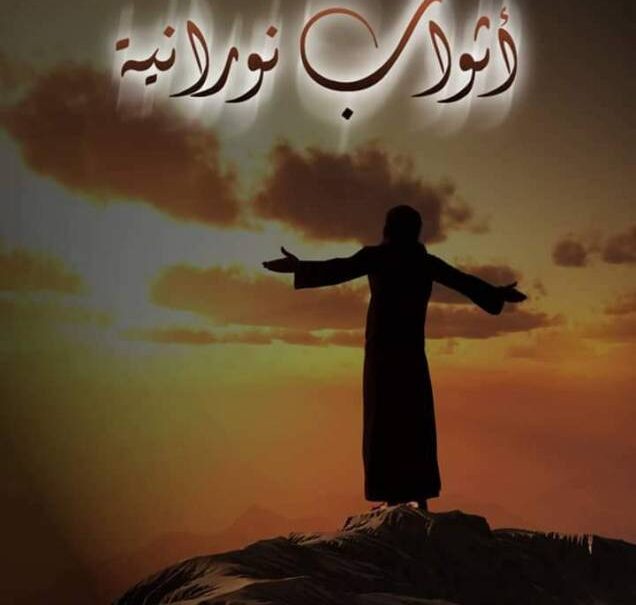The garments sewn by the lights of the heavens

By Sheikh Rabih Qubaisi.
When I first heard about the documentary titled “The Garments of piety,” my curiosity led me to eagerly await its screening at the National Lebanese Theater in the city of Tyre, invited by the Tyre Arts Association. I wanted to see which light I would have the honor of witnessing and the work under its radiant shadow. The title and content were different, a new situation presented in the world of visual and auditory culture.
Upon entering the tranquil theater, I observed its serenity, like a cradle of a newborn. Its music resonated with the walls, seats, and lights. There, the voice of Qassem Istanbuli, the director and artist who adorns the place with the brush of peace and the noble message of art, initiated my anticipation for the details that would share with me the viewing of the luminous garments in the presence of the creator, Zalfa Assaf, the producer, director, and artist.
The presentation began, and we ascended together towards the sublime, accompanied by calls to prayer, light, prayers, church bells, and whispers of solitary retreats. For an hour, with minutes of silence, tranquility, and dignity, we watched with all our senses. As we returned to our reality, we carried within us much spiritual and psychological beauty. At that moment, a bouquet of titles crystallized in my mind. I will try to summarize them in this article, knowing that words cannot do justice to this great and exceptional work needed in our country Lebanon today, as part of the effort to fuse the Lebanese people with the culture of citizenship, nationhood, leaving sectarianism and discord behind.
This documentary film works to build a social reality based on spiritual connection between divine messages, diverse doctrines, all converging towards the value of human beings and their service and development to build a society that looks towards a complete future to achieve the loftiest goals of human creation.
Director Zalfa Assaf proved that she is a Lebanese woman trying to bring together the sons of the country and find common ground that leads to the success of the Lebanese experience in all its components. As Pope Saint Paul II expressed, “This country, which has been struck a thousand times, tries a thousand times to be reborn for a new life. Lebanon is more than a country; it is a message of freedom and an example of diversity for the East as well as the West. Zalfa Assaf and her assisting team worked to confirm that Lebanon is a land of peace, meeting, love, and openness to the different other. Transparently, if we reflected the colors of the garments that glorify the Creator, as seen with simplicity, love, and reassurance in the film, we could change many corrupted thoughts. We could plant peace and love with each thread and stitch, aiming to elevate society to accept and understand differences, not making them a source of conflict among the children of humanity.
Through what Zalfa Assaf has accomplished, we can draw a roadmap for the idea of diversity and accepting the different other in beliefs while emphasizing the unity of purpose and goal, especially in Lebanon, the most beautiful country that deserves its lights to reach towards the sky as its luminous garments praise the Almighty. As Sayyid Musa al-Sadr expressed in one of his speeches, “Lebanon is a civilized necessity for the world, and coexistence is a global responsibility on the shoulders of the Lebanese. If the Lebanese experience falls, it will darken the human experience.”
Director Zalfa Assaf used the spirit of unity without discrimination and the meeting of souls rather than the meeting of fabric with fabric. She reflected the beauty of colors, embroidery, and embellishments, as she illuminated details not known even to some of the wearers. She highlighted details observed by people every morning and evening, every Friday and Sunday in churches, mosques, retreats, and Husseiniyat without knowing the reason for their differences in colors, patterns, embroidery, and folds. In short, she illuminated a window towards knowledge that should be within society. With simplicity, she addressed the issue with all the details of the content.
While watching the film, I recalled how many times I asked myself about various garments and how many times people asked me about the meanings of clothes they did not understand. But today, with confidence, I can guide them towards a well-documented, objective source that is almost complete. It serves as a real reference for this comprehensive title, which should be the beacon of the heart’s lights before the garments.
All thanks and appreciation for this exceptional work. Zalfa Assaf deserves a thread of light from the garments of love and respect to accompany her wherever she spreads knowledge and awareness in our homeland Lebanon. Thanks are also extended to the friend, director Qassem Istanbuli, for hosting this work within his annual activities aimed at equality, accepting the other, and cultural exchange in the city of Tyre.By Sheikh Rabih Qubaisi.
When I first heard about the documentary titled “The Garments of piety,” my curiosity led me to eagerly await its screening at the National Lebanese Theater in the city of Tyre, invited by the Tyre Arts Association. I wanted to see which light I would have the honor of witnessing and the work under its radiant shadow. The title and content were different, a new situation presented in the world of visual and auditory culture.
Upon entering the tranquil theater, I observed its serenity, like a cradle of a newborn. Its music resonated with the walls, seats, and lights. There, the voice of Qassem Istanbuli, the director and artist who adorns the place with the brush of peace and the noble message of art, initiated my anticipation for the details that would share with me the viewing of the luminous garments in the presence of the creator, Zalfa Assaf, the producer, director, and artist.
The presentation began, and we ascended together towards the sublime, accompanied by calls to prayer, light, prayers, church bells, and whispers of solitary retreats. For an hour, with minutes of silence, tranquility, and dignity, we watched with all our senses. As we returned to our reality, we carried within us much spiritual and psychological beauty. At that moment, a bouquet of titles crystallized in my mind. I will try to summarize them in this article, knowing that words cannot do justice to this great and exceptional work needed in our country Lebanon today, as part of the effort to fuse the Lebanese people with the culture of citizenship, nationhood, leaving sectarianism and discord behind.
This documentary film works to build a social reality based on spiritual connection between divine messages, diverse doctrines, all converging towards the value of human beings and their service and development to build a society that looks towards a complete future to achieve the loftiest goals of human creation.
Director Zalfa Assaf proved that she is a Lebanese woman trying to bring together the sons of the country and find common ground that leads to the success of the Lebanese experience in all its components. As Pope Saint Paul II expressed, “This country, which has been struck a thousand times, tries a thousand times to be reborn for a new life. Lebanon is more than a country; it is a message of freedom and an example of diversity for the East as well as the West. Zalfa Assaf and her assisting team worked to confirm that Lebanon is a land of peace, meeting, love, and openness to the different other. Transparently, if we reflected the colors of the garments that glorify the Creator, as seen with simplicity, love, and reassurance in the film, we could change many corrupted thoughts. We could plant peace and love with each thread and stitch, aiming to elevate society to accept and understand differences, not making them a source of conflict among the children of humanity.
Through what Zalfa Assaf has accomplished, we can draw a roadmap for the idea of diversity and accepting the different other in beliefs while emphasizing the unity of purpose and goal, especially in Lebanon, the most beautiful country that deserves its lights to reach towards the sky as its luminous garments praise the Almighty. As Sayyid Musa al-Sadr expressed in one of his speeches, “Lebanon is a civilized necessity for the world, and coexistence is a global responsibility on the shoulders of the Lebanese. If the Lebanese experience falls, it will darken the human experience.”
Director Zalfa Assaf used the spirit of unity without discrimination and the meeting of souls rather than the meeting of fabric with fabric. She reflected the beauty of colors, embroidery, and embellishments, as she illuminated details not known even to some of the wearers. She highlighted details observed by people every morning and evening, every Friday and Sunday in churches, mosques, retreats, and Husseiniyat without knowing the reason for their differences in colors, patterns, embroidery, and folds. In short, she illuminated a window towards knowledge that should be within society. With simplicity, she addressed the issue with all the details of the content.
While watching the film, I recalled how many times I asked myself about various garments and how many times people asked me about the meanings of clothes they did not understand. But today, with confidence, I can guide them towards a well-documented, objective source that is almost complete. It serves as a real reference for this comprehensive title, which should be the beacon of the heart’s lights before the garments.
All thanks and appreciation for this exceptional work. Zalfa Assaf deserves a thread of light from the garments of love and respect to accompany her wherever she spreads knowledge and awareness in our homeland Lebanon. Thanks are also extended to the friend, director Qassem Istanbuli, for hosting this work within his annual activities aimed at equality, accepting the other, and cultural exchange in the city of Tyre.
